The “Swissy” is regarded as one of the safest currencies on world markets with a relatively stable economy and political neutrality.
Mean reversion or trend pullback systems work well when there is some sort of trend to pull back from. The long-term chart of the Swissy below shows how it has been in a fairly consistent downtrend since 2000.
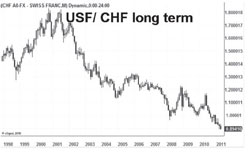
Zooming in on specific periods we can see some points that near perfect for pullback strategies.
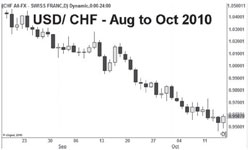
The chart above shows the USD/ CHF between August 2010 and October 2010. Shorting pullbacks against the downtrend was an easy strategy during this period and shorting after two up days was near perfect over these months.
So the USD/ CHF has all the characteristics that should make it suitable for overbought/oversold strategies like those employed by the DV1, but does it work this way in reality?
Swinging the Swissy
We are going to look at extreme positions for the indicator (i.e. buy into extreme weakness and sell into extreme strength). With the DV1, a low score is something below 25 while a high score is something above 75.
The conditions are as follows:
Buy: DV1 0.75
Sell: DV1 >0.75. Close Sell DV1 <0.25
The system is “always in” meaning you enter short at high readings and stay short until you get a low reading, at which point you switch long.
The returns have been excellent since 2000 returning a grand total of 19,333 pips from both long and short trades. If you had had the foresight to buy Swiss francs against the US dollar and simply hold them, you would have profited, but still just to the tune of 5,000 pips.
Below you can see the non-compounded returns from this strategy in pips form. The equity curve is steady, give or take the odd bump, which is to be expected with any system.
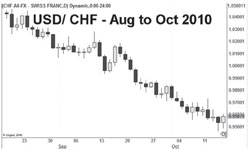
The statistics for long and short trades are encouragingly even given in terms of strike rate with the bulk of gains predictably coming from the short side trades:
Long trades:
Total: 7,144 pips
Average winner: 111 pips
Average loser: 169 pips
Strike rate: 66%
Short trades:
Total: 12,189 pips
Average winner: 106 pips
Average loser: 138 pips
Strike rate: 68%
Typical of many mean reversion strategies the average winner is smaller than the average loser; this is because the system can often get in too early in going against the trend, resulting in one or two big losses before things turn around.
The best way to cope with this is to stagger entries into 1/3 lots. Quite often you will get secondary and even tertiary buy or sell signals, before the exit signal is given. By staggering your entry across three lots, the risk can be managed effectively.
Depending on your appetite for risk, you could look at dividing entries by 2 instead of 3. For an aggressive strategy you might enter a new position with each follow-on signal. The simplest method would be to simply take the first signal – and ignore subsequent signals – as this is what the test results are based on.
Example trades:
Below we can see an example trade from January. We’re using a daily chart with the DV1 indicator displayed below.
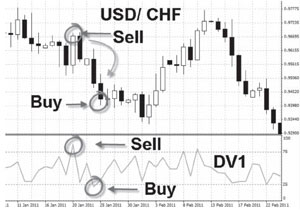
The DV1 hit 75 on 20th January, signalling a short entry to be made at the close around 0.9673. The price immediately reversed, giving a signal to buy back on the 25th around 0.9423 for a total profit of 250 pips over four days.
Skipping ahead, we have an example of why entering in 1/3 lots can be extremely advantageous:
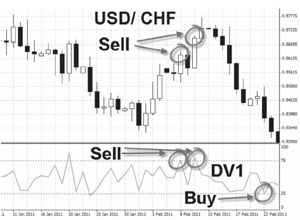
The DV1 just touched 75 on 8th February triggering a sell signal at the close around 0.9630. A second buy signal was triggered on the 10th triggering another sell signal around 0.9693. The price then dropped with the DV1 not signalling an exit until the 22nd at the close around 0.9383.
That made a 247 pip profit on the first position and a 310 pip profit on the 2nd position. Using a thirds entry strategy, the total return would be 186 pips taking into account the unfilled final third.
Intraday trading
Another way to use this strategy is to wait for confirming intraday action or to use the DV1 to confirm intraday set-ups.
The trade below is a good example of this:
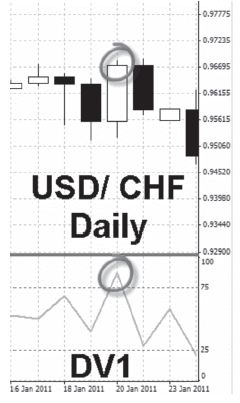
Going back to the short position triggered on the 20th, you might have noted the sell signal and been biased towards any day trade set-ups in that direction only.
Switching to a 4-hour chart, we can see what happened with the USD/ CHF overnight. Three times the USD/ CHF tried to get higher than 0.9680, but failed every time.
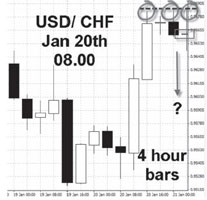
Arriving at your desk in the morning at 08.00 AM this is the set-up that would have greeted you. The price is clearly struggling to go higher and coupled with the DV1 sell signal last night, you have a promising short set-up around 0.9662.
Here’s what happened for the rest of the day.
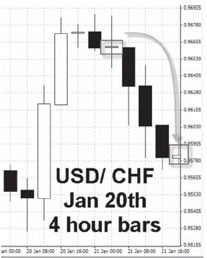
Had you held until near the close around 0.9582 you could have realised a nice profit of 80 pips.
The bottom line
The USD/ CHF is an often-overlooked currency, trading in the shadow of its European neighbour the EUR/ USD. However, when combined with short- term indicators that suit the pair’s trading character, the USD/ CHF can be a great pair to trade.
